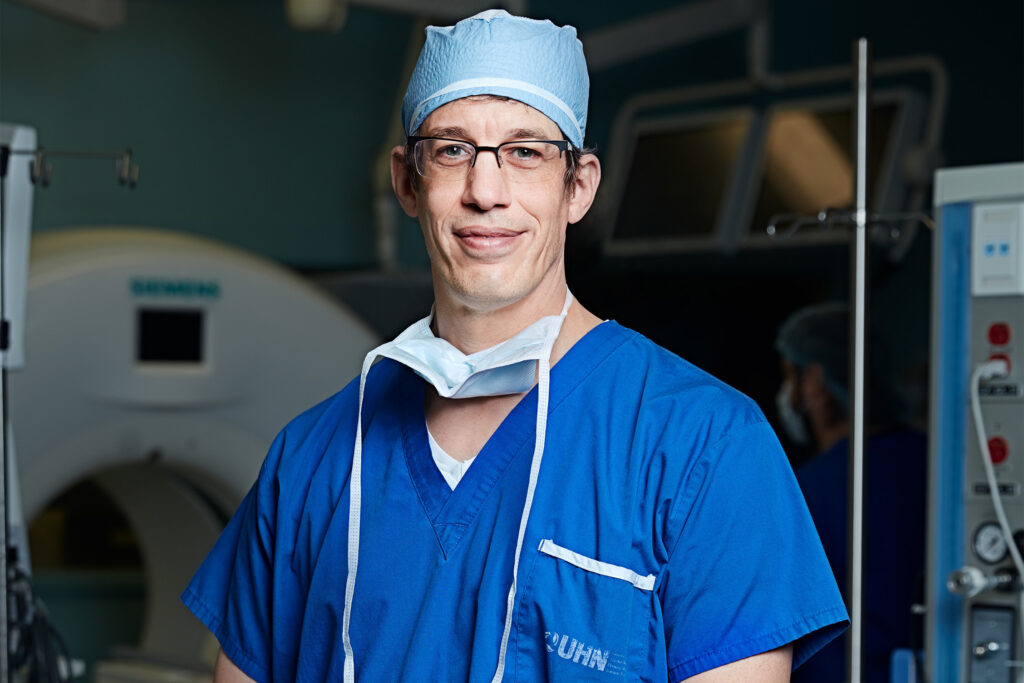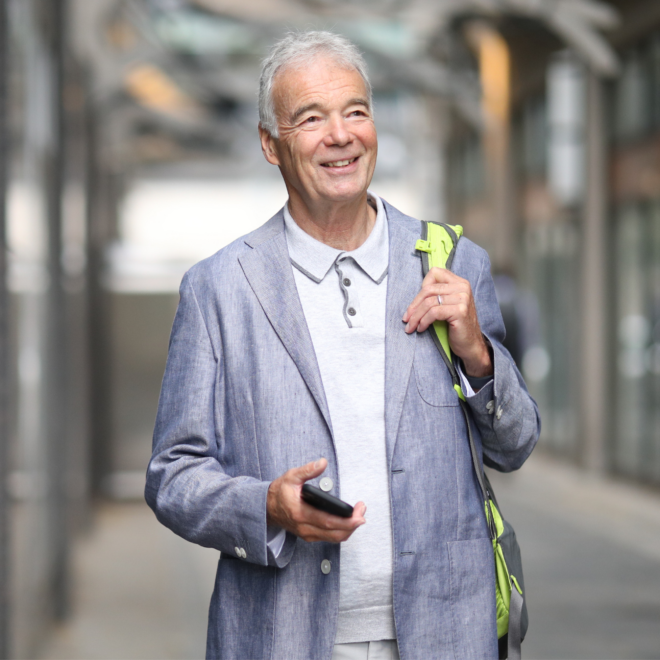Individualized treatments for a unique disease
By uniting a full team of specialists and treating each case as unique as each patient, Dr. George Oreopoulos is leading the way in treating rare vascular malformations.
In 1994, when Fareed Mohammed was in high school, he had his first bout of unexplained bleeding. “I was standing for the morning assembly at school and realized there was blood pooling in my shoe,” says Mohammed.
He would later be diagnosed with what is now known as Parkes-Weber syndrome, a rare and potentially recurring condition that has only been defined in the last 15 years. In these rare cases, blood vessels in the body’s vascular system can become entangled and multiple irregular connections occur that prevent oxygen-rich blood from reaching its destination. If a malformation occurs in a vessel that supplies a major organ, like the heart or kidneys, organ failure can happen.
In 2012, the blood vessels in Mohammed’s leg pressed so hard against his skin that they became exposed and bled spontaneously. Burning pain became an everyday reality for Mohammed and moving around took effort. “The pain was excruciating and endless,” he says.

This is when he first met Dr. George Oreopoulos, vascular surgeon and lead of the Vascular Malformation Clinic at the Peter Munk Cardiac Centre at Toronto’s University Health Network (UHN). Dr. Oreopoulos embolized, or blocked, the bleeding vessels as the first line of treatment.
A problem two inches wide and two feet deep
What’s perplexing about vascular malformations is there are many unique characteristics of the disease to every patient, making each case different – like a fingerprint. According to Dr. Oreopoulos, that makes treating it a problem “two inches wide and two feet deep.” He explains, “We have to step back from our training in some ways and look at each individual completely differently. There is no common pathway for this disease.”
Dr. Oreopoulos and his team approach each case as unique, creating individualized treatments for each patient. “Fareed has had embolization treatments, blood transfusions to improve his clotting factors and stentgrafts inserted into the arteries in his leg, which historically is a technique used primarily in aneurysm surgeries,” Dr. Oreopoulos explains.
“There is no common pathway for this disease.”
Dr. George Oreopoulos, on treating rare vascular malformations
15 years
Parkes-Weber syndrome, a rare and potentially recurring vascular malformation condition has only been defined in the last 15 years.
This kind of individualized treatment is what sets apart the Vascular Malformation Clinic at the Peter Munk Cardiac Centre. As one of only a few providers in Canada to offer highly specialized care in treating this rare disease, it’s the go-to destination for the most complex of cases with patients visiting from all over Canada. The goal is to become a Centre of Excellence that can provide the medical training, research and coordinated care necessary to save lives.
Uniting a full team of specialists
“So much of this is new medicine,” explains Dr. Oreopoulos. “What do you do when you are faced with something you have rarely seen before? You phone a friend. You draw parallels. Vascular malformations in the brain are well known but what Fareed and patients like him are facing is new territory for the medical field. Coalescing other resources and experts is key to treatment.”
When Dr. Oreopoulos, who is also the Postgraduate Surgery Education Director in UHN’s Sprott Department of Surgery, was learning about vascular malformations, the existence of a multidisciplinary clinic for this problem with an array of medical specialties was considered novel.
Now, he has united a full team of specialists to treat vascular malformation. There are brain specialists, radiologists, specialized wound care nurses, orthopedic specialists, psychologists, plastic surgeons and cardiologists who are now frequently involved in the Vascular Malformation Clinic.
In 2020, when Mohammed required an above-knee amputation to treat a ruptured ulcer caused by his recurring vascular malformations, Dr. Oreopoulos and the dedicated staff at the Peter Munk Cardiac Centre were ready with all the specialties that might be needed in the operating room (OR), including a cardiac anesthetist, interventional radiologist, a second vascular surgeon and a perfusionist to run a cell-saver device.
“Coalescing other resources and experts is key to treatment.”
Dr. George Oreopoulos
The new and advanced state-of-the-art imaging equipment in the multipurpose operation room was critical in providing the team with real-time diagnostics on the various procedures Mohammed underwent to save his leg. “I’m not sure things would have gone as smoothly without being at the Peter Munk Cardiac Centre,” says Mohammed. He believes it’s not only practitioners like Dr. Oreopoulos, but also the Peter Munk Cardiac Centre that was critical to saving his life.
Joining the team who saved his life
Throughout his treatments, Mohammed married, graduated college and had three daughters with his wife, Cindy. In 2004, Mohammed decided to join the exceptional team who saved his life. He became a Medical Laboratory Technologist in the blood bank at UHN, where he has worked ever since.
“My family, my colleagues and my doctors remind me I am not alone,” says Mohammed. “The nurses and doctors who have attended to me always approach me with positivity and optimism. This has made a huge difference in my recovery.”
“Today, vascular medicine is growing in leaps and bounds.”
Fareed Mohammed
Now, with a cane in hand, Mohammed is back to a quality of life he has not experienced in 10 years. “I can go to the movies now and mow the lawn. We took a small trip to Montreal this summer. I’m at work every day. Life is pretty good,” Mohammed says, singing the praises of his team at the Peter Munk Cardiac Centre.
“Today, vascular medicine is growing in leaps and bounds due to the work of Dr. Oreopoulos and the team and the new approaches they take in controlling the ongoing issues people like me suffer from,” says Mohammed. “It’s really nice when I pass him in the hall at work, we smile at each other like we share a secret, like we’ve been through something together.”

